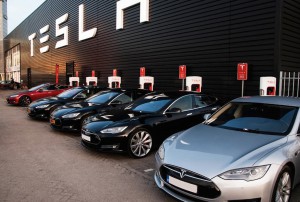
Tesla's Model S will be one of the first examples of vehicles using autonomous vehicle technology on the road this summer.
Pandora’s Box is now officially open.
The emergence of self-driving vehicles as a major force in the automotive industry was underscored this week during the Society of Automotive Engineers conference in Detroit, where the topic of self-driving easily eclipsed fuel-efficiency as the major topic of discussion.
Seval Oz, chief executive officer of Intelligent Transportation Systems at Continental AG, said two of the factors that are driving the autonomous car revolution are exponential growth of wireless connectivity in cars and the demand by other companies for the attention of drivers and passengers, who spend upwards of two hours in a vehicle during the daily commute.
The rapid growth of connectivity makes it possible to use even a stationary vehicle to take delivery of packages and groceries, said Oz, whom Continental hired away from Google in 2014 to head up their new unit based in Santa Clara, California.
Another factor coming into play is the push of non-automotive companies into the space. More and more companies and services, not just Apple and Google, are seeing the potential of partnering up with auto companies and major suppliers, Oz said.
“It’s not a zero-sum game,” she said. “It’s one plus one plus one.”
A new study by the Boston Consulting Group (BCG), which was done independently of the SAE conference, also noted that the development of autonomous-driving technology is gaining momentum, and vehicles with varying levels of self-driving capability will start to become available to consumers as early as this summer.
An earlier BCG analysis, released in January, predicted that self-driving features could represent a $42 billion market by 2025. It also predicted that partially autonomous vehicles, powered by surprisingly strong consumer interest, were likely to hit the road in large numbers by 2017. A series of enhancements would then follow, making fully self-driving cars a market reality within one decade and a common sight within two.
(Regulators, automakers key to autonomous vehicle success. For more, Click Here.)
“The auto industry is at its most significant inflection in a century,” said Xavier Mosquet, a senior partner and managing director in BCG’s Detroit office, the North America leader of the firm’s Automotive practice, and a coauthor of the report.
“Self-driving vehicles will hit the road sooner than many people realize. And although the journey to market maturity will take 20 years or more, it’s not too soon for auto executives, regulators, and all players in the transportation and tech spheres to start preparing for the sweeping changes on the horizon,” he said.
Mosquet’s comments echo those of SAE participants. Ray Kurzweil, executive director of engineering at Google, said developments in self-driving cars will come quickly thanks to advances in artificial intelligence.
(Click Here for details about one Google exec’s opinions about self-driving cars.)
Bernhard Sendhoff, resident, Honda Research Institute Europe, noted during a panel discussion that while the construction of the Acura NSX, has gotten a lot of attention, the new supercar from Honda will also have some of the most sophisticated driving assistance features and electronics ever seen on a production The NSX is due out late this year, Honda spokesmen said.
Mosquet said the age of the autonomous will arrive not all at once, of course, but in stages.
The first autonomous feature to become available will probably be the single-lane highway autopilot, with Tesla’s planned introduction in mid-2015, followed by GM’s version of the feature, called Super Cruise, which will appear in 2016 on an all-new Cadillac vehicle.
(To see more about how autonomous vehicles might make you car sick, Click Here.)
By 2017, autonomous vehicles capable of traffic jam autopilot and autonomous valet parking should be on dealers’ lots, followed by highway autopilot with lane changing in 2018. Vehicles capable of urban autopilot could be ready in 2022, paving the way for fully autonomous vehicles by 2025 — the year when Mercedes, for one, expects to debut its first full autonomous model.

Authorities had better think long and hard and implement the proper regulations to prevent the worst of problems that are obvious regarding autonomous vehicles. Being proactive is far better than the knee-jerk reactions after issues arise.
There is a whole lot of work to be done long before any autonomous vehicles should be allowed to operate on the roadways. The UK for some reason feels this is their golden opportunity to rebuild their economy by being the leaders in the area of autonomous vehicles so they are rushing ahead with on highway testing without addressing many of the social issues involved. This may lead to a very bad ending.